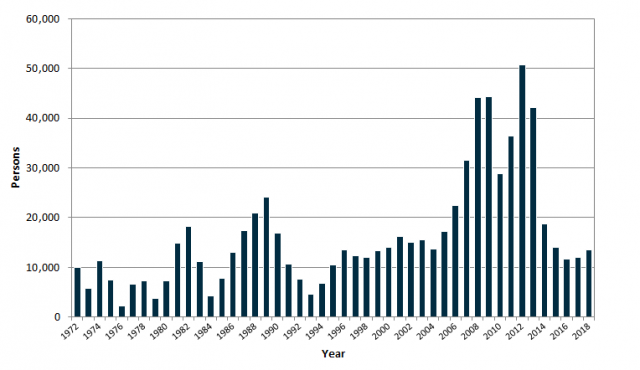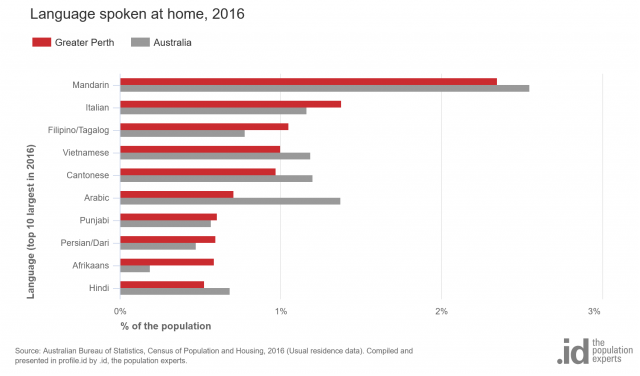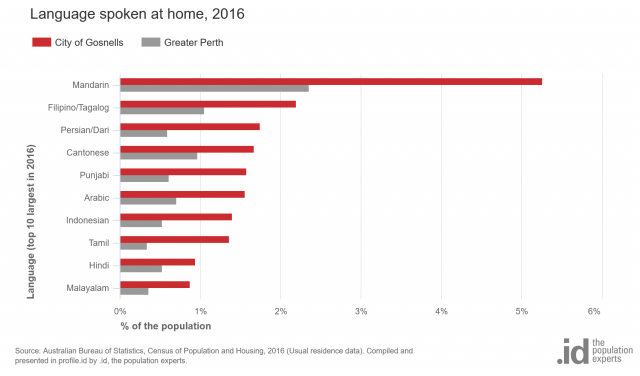Overseas migration has always played a key role in Western Australia’s population, but the past decade has seen some significant changes. In today’s post, Glenn takes a deep dive into the changing migration patterns in Perth and around the state, and the move towards more multicultural cities.
While Perth might not be the most remote in the world, it is nevertheless quite remote from any other large city, and tends to follow its own population trends, which have a lot to do with Western Australia’s boom and bust cycles based on mining and construction. One really interesting trend which happened over the last 10 years has been a big increase in multicultural populations in Perth – an increase seen elsewhere in Australia too, but not quite to the same magnitude.
Western Australia has always been a state founded on overseas migration. It has the largest percentage overseas-born of any state in Australia, at 32.2% of population in 2016. This has mainly been founded on a very large United Kingdom and South African-born population, and this continues on. Greater Perth continues to have over 10% of population born in the UK, and receives further migration every year from England, Scotland, Wales and Northern Ireland. Suburbs along the coast, such as Burns Beach in the City of Joondalup, have around 30% of the population born in the UK.
How has migration to Perth and WA changed?
In the last 10 years Perth – and WA more widely – has been getting a substantially larger share of migrants from non-English speaking countries. Couple this with the very high overall migration levels seen in the mining boom years, and Perth is rapidly changing into a very multicultural city.
Net Overseas Migration, Western Australia, 1972 to 2018

What language groups are represented?
This is evident in the languages spoken in the Greater Perth area.
In the 10 years from 2006 to 2016, Greater Perth’s percentage of population speaking a language other than English has risen from 13.3%, to 20.1% of population. This is a huge increase, and represents 44% of Perth’s total population growth of 431,000 people in this time period. So almost half of Perth’s population growth is due to people who speak a language other than English.
While the total of 20.1% is still well below that found in our most multicultural cities of Sydney (35.8%) and Melbourne (32.3%), it represents a larger percentage increase than either of these capitals, and the largest increase in multicultural population of any region in Australia.
These are the main languages spoken in Perth (other than English) in 2016.


All of the top 10 languages, except Italian, have increased in 10 years. The growth in Mandarin speakers, and Indian-language speakers (split among Hindi, Punjabi etc.) is quite astounding. Mandarin alone increased by almost 30,000.
How will councils respond?
It is fair to say Perth has not been known for being a very multicultural city before this, and it has taken the region by surprise, to some extent. Local Government in Sydney and Melbourne are in many ways set up to deal with multicultural populations. Settlement services, translations and labour force assistance for new arrivals are in many cases part of the remit of Local Government. This has been the case only to a lesser extent in Perth, and many councils are now grappling with how to engage with and provide services for a very language-diverse population.
Nowhere is this more evident than the epicentre of migration, the South-Eastern suburbs of Perth. This includes the cities of Belmont, Canning, Gosnells, and Armadale, all of which have seen a very large increase in multicultural populations.
A closer look at Gosnells
Take the City of Gosnells for example. Their non-English-speaking-background population has gone from 13.6% in 2006, when it was around the Perth average, to a massive 31.6% in 2016. In 10 years the number of people speaking a language other than English more than tripled, from about 12,000 to 37,000.

.png?width=640&height=376&name=Lang_Gosnells_Change-640x376%20(1).png)

This is an incredible change in one Local Government Area of just over 100,000 people and, as you can see, while Chinese speakers make up a large part of it, it’s spread across many diverse groups – the essence of multiculturalism. With such change in a short period of time, it’s no wonder LGAs aren’t really set up to deal with the demands of diverse populations yet.
It’s a similar story in nearby Canning (22.5% to 39.7% in 10 years), Armadale (5.7% to 18.7%) and Belmont (14.9% to 29.5%).
How can you get a clearer picture?
The Communities of Interest module is an add-on to profile.id, which provides councils with a great deal of evidence around the characteristics of multicultural communities. For total overseas-born or non-English speaking, or a specific birthplace or language group, users can look at age structures, cultural background, qualifications, workforce participation, household and dwelling characteristics. These groups in the local area can be compared to the same group elsewhere, to the total population, and can look at change over time.
If your multicultural population is large, or increasing, or both, it’s worth considering adding this module to give you the wherewithal to plan services and understand your multicultural community better.
For more information on the Communities of Interest, see this blog post.





.png?width=640&height=376&name=Lang_Gosnells_Change-640x376%20(1).png)









